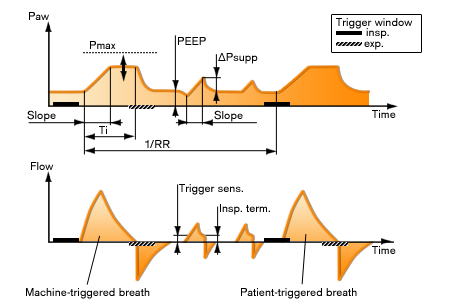- Device Gallery
- Device cockpit
- Mixer unit and status display
- Vapor 3000
- Vapor Mount
- Integrated Breathing System
- External fresh-gas outlet
- CO2 absorber
- Space for storage
- Working surface
- Trolley
- Hooks and brackets
- Anesthetic Gas Receiving System (AGRS)
- Mounting rails
- Column cover
- Cable channel
- Gas Inlet
- Interfaces
- Endotracheal Suction System
- Patient monitoring and IT
- Shelves
- Vapor 3000
- Ventilator (TurboVent 2)
- Ventilation Modes
- Device Monitoring
- Operating Concept
- Abbreviations
- Symbols
- Test
Vol. Ctrl. AutoFlow

With AutoFlow, the set tidal volume VT is applied for all mandatory volume-controlled breaths with the lowest required pressure. The patient can breathe spontaneously throughout the entire respiratory cycle, during both inspiration and expiration. The pressure patterns and flow patterns of the mechanical inspiratory breaths correspond to those of pressure-controlled ventilation.
Due to the patient's spontaneous breathing efforts or compliance changes in the lungs, the tidal volume in an individual breath may deviate from the set tidal volume VT. However, on a time average a tidal volume corresponding to the set volume VT is applied.
To estimate the lung parameters, a number of test breaths is required when starting a ventilation mode with AutoFlow. These test breaths comprise the basis for calculation of the ventilation pressure. Starting with the third inspiratory breath, the ventilation pressure is set to the calculated target pressure. Each additional breath-related readjustment of the inspiratory pressure is limited to ±3 hPa (cmH2O).
Volume Control - CMV / AF
- Volume-controlled.
- Time-controlled.
- Machine-triggered.
- Decelerating inspiratory flow.
The mandatory breaths are machine-triggered and are not triggered by the patient.
Volume Control - SIMV / AF
- Volume-controlled.
- Time-controlled.
- Machine-triggered.
- Synchronized with inspiration and expiration.
In Volume Control - SIMV / AF, the patient can breathe spontaneously at any time, while the number of mandatory breaths is predefined. When synchronization is switched on, the breaths are adapted to the spontaneous breathing efforts of the patient.
Volume Control - SIMV / AF / PS (optional)
This mode is similar to Volume Control - SIMV / AF, except that the patient's spontaneous breathing at the PEEP level is pressure-supported with ΔPsupp when outside the trigger window.
